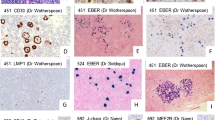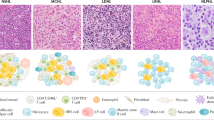Abstract
T cell/histiocyte-rich large B-cell lymphoma (THRLBCL), originally considered an uncommon variant of Diffuse Large B-Cell Lymphoma (DLBCL), is recognized by the World Health Organisation as a separate clinicopathological entity since 2008. It predominantly affects middle aged men often presenting with advanced stage disease frequently involving spleen, liver and bone marrow at time of diagnosis. According to the WHO, this lymphoma is morphologically characterized by less than 10% of large neoplastic B cells in a background of abundant T cells and frequently histiocytes. Differentiating THRLBCL from other lymphoproliferative disorders such as Nodular Lymphocyte Predominant Hodgkin Lymphoma (NLPHL) and Lymphocyte-Rich classical Hodgkin lymphoma (LRcHL) is important from a clinical point of view and can be achieved in most cases, given adequate biopsy specimens, by careful morphological and immunohistochemical evaluation of both the neoplastic cells as well as the nonneoplastic stromal component. According to this WHO definition, THRLBCL is still considered a clinically heterogeneous entity, though it is noted that especially the cases containing numerous histiocytes behave aggressively and show resistance to current therapies for DLBCL. Gene expression profiling studies of THRLBCL provided evidence for a prominent role for this histiocytic component that is important for a tolerogenic host immune response in which they may assist neoplastic cells in escaping the T cell-mediated immune surveillance. Therefore, reserving the diagnosis of THRLBCL to cases containing a large proportion of histiocytes might be relevant, as modulating their activity could provide new therapeutic options.

Similar content being viewed by others
References
Jaffe E et al (1984) Diffuse B cell lymphoma with T cell predominance in patients with follicular lymphoma or ‘pseudo T cell lymphoma’. Lab Investig 50:27A–28A
Mirchandani I et al (1985) B-cell lymphomas morphologically resembling Tcell lymphomas. Cancer 56:1578–1583
Ramsay AD, Smith WJ, Isaacson PG (1988) T-cell-rich B-cell lymphoma. Am J Surg Pathol 12(6):433–443
Chittal SM et al (1991) Large B-cell lymphoma rich in T-cells and simulating Hodgkin’s disease. Histopathology 19(3):211–220
Delabie J et al (1992) Histiocyte-rich B-cell lymphoma. A distinct clinicopathologic entity possibly related to lymphocyte predominant Hodgkin’s disease, paragranuloma subtype. Am J Surg Pathol 16(1):37–48
Gatter KC, Warnke R (2001) Diffuse large B-cell lymphomas. In: Jaffe ES, Harris NL, Stein H, Vardiman J (eds) World Health Organization classification of tumours. Pathology and genetics of tumours of haematopoietic and lymphoid tissues. IARC Press, Lyon, pp 171–4
Bouabdallah R et al (2003) T-cell/histiocyte-rich large B-cell lymphomas and classical diffuse large B-cell lymphomas have similar outcome after chemotherapy: a matched-control analysis. J Clin Oncol 21(7):1271–1277
De Wolf-Peeters C, Pittaluga S (1995) T-cell rich B-cell lymphoma: a morphological variant of a variety of non-Hodgkin’s lymphomas or a clinicopathological entity? Histopathology 26(4):383–385
Greer JP et al (1995) T-cell-rich B-cell lymphomas: diagnosis and response to therapy of 44 patients. J Clin Oncol 13(7):1742–1750
Harris NL (1999) Hodgkin’s lymphomas: classification, diagnosis, and grading. Semin Hematol 36(3):220–232
Krishnan J, Wallberg K, Frizzera G (1994) T-cell-rich large B-cell lymphoma. A study of 30 cases, supporting its histologic heterogeneity and lack of clinical distinctiveness. Am J Surg Pathol 18(5):455–465
Lim MS et al (2002) T-cell/histiocyte-rich large B-cell lymphoma: a heterogeneous entity with derivation from germinal center B cells. Am J Surg Pathol 26(11):1458–1466
Rodriguez J, Pugh WC, Cabanillas F (1993) T-cell-rich B-cell lymphoma. Blood 82(5):1586–1589
Achten R et al (2002) T-cell/histiocyte-rich large B-cell lymphoma: a distinct clinicopathologic entity. J Clin Oncol 20(5):1269–1277
Swerdlow SH, Campo E, Harris NL, Jaffe ES, Pileri SA, Stein H et al (2008) WHO classification of tumours of haematopoietic and lymphoid tissues, 4th edn. International Agency for Research on Cancer, Lyon
Dogan A et al (2003) Micronodular T-cell/histiocyte-rich large B-cell lymphoma of the spleen: histology, immunophenotype, and differential diagnosis. Am J Surg Pathol 27(7):903–911
Fraga M et al (2002) T-cell/histiocyte-rich large B-cell lymphoma is a disseminated aggressive neoplasm: differential diagnosis from Hodgkin’s lymphoma. Histopathology 41(3):216–229
Gascoyne RD et al (1997) Prognostic significance of Bcl-2 protein expression and Bcl-2 gene rearrangement in diffuse aggressive non-Hodgkin’s lymphoma. Blood 90(1):244–251
Diehl V et al (1999) Clinical presentation, course, and prognostic factors in lymphocyte-predominant Hodgkin’s disease and lymphocyte-rich classical Hodgkin’s disease: report from the European Task Force on Lymphoma Project on Lymphocyte-Predominant Hodgkin’s Disease. J Clin Oncol 17(3):776–783
Abramson JS (2006) T-cell/histiocyte-rich B-cell lymphoma: biology, diagnosis, and management. Oncologist 11(4):384–392
Brauninger A et al (1999) Molecular analysis of single B cells from T-cell-rich B-cell lymphoma shows the derivation of the tumor cells from mutating germinal center B cells and exemplifies means by which immunoglobulin genes are modified in germinal center B cells. Blood 93(8):2679–2687
Marafioti T et al (1997) Origin of nodular lymphocyte-predominant Hodgkin’s disease from a clonal expansion of highly mutated germinal-center B cells. N Engl J Med 337(7):453–458
Van Loo P et al (2009) T-cell/histiocyte-rich large B-cell lymphoma shows transcriptional features suggestive of a tolerogenic host immune response. Haematologica 95(3):440–448
Fan Z et al (2003) Characterization of variant patterns of nodular lymphocyte predominant hodgkin lymphoma with immunohistologic and clinical correlation. Am J Surg Pathol 27(10):1346–1356
Hansmann ML et al (1989) Nodular paragranuloma can transform into high-grade malignant lymphoma of B type. Hum Pathol 20(12):1169–1175
Boudova L et al (2003) Nodular lymphocyte-predominant Hodgkin lymphoma with nodules resembling T-cell/histiocyte-rich B-cell lymphoma: differential diagnosis between nodular lymphocyte-predominant Hodgkin lymphoma and T-cell/histiocyte-rich B-cell lymphoma. Blood 102(10):3753–3758
Torlakovic E et al (2001) The transcription factor PU.1, necessary for B-cell development is expressed in lymphocyte predominance, but not classical Hodgkin’s disease. Am J Pathol 159(5):1807–1814
Sanders ME et al (1988) Molecular pathways of adhesion in spontaneous rosetting of T-lymphocytes to the Hodgkin’s cell line L428. Cancer Res 48(1):37–40
Lones MA, Cairo MS, Perkins SL (2000) T-cell-rich large B-cell lymphoma in children and adolescents: a clinicopathologic report of six cases from the Children’s Cancer Group Study CCG-5961. Cancer 88(10):2378–2386
Tiemann M et al (2005) Proliferation rate and outcome in children with T-cell rich B-cell lymphoma: a clinicopathologic study from the NHL-BFM-study group. Leuk Lymphoma 46(9):1295–1300
Axdorph U et al (2002) T-cell-rich B-cell lymphoma—diagnostic and therapeutic aspects. APMIS 110(5):379–390
Jaffe E, Muller-Hermelink H (1999) Relationship between Hodgkin’s disease and nonHodgkin’s lymphomas. In: Mauch P, Armitage J, Diehl V et al (eds) Hodgkin’s disease. Lippincott Raven, Philadelphia, pp 181–194
Osborne BM, Butler JJ, Pugh WC (1990) The value of immunophenotyping on paraffin sections in the identification of T-cell rich B-cell large-cell lymphomas: lineage confirmed by JH rearrangement. Am J Surg Pathol 14(10):933–938
Achten R et al (2002) Histiocyte-rich, T-cell-rich B-cell lymphoma: a distinct diffuse large B-cell lymphoma subtype showing characteristic morphologic and immunophenotypic features. Histopathology 40(1):31–45
Braeuninger A et al (1997) Hodgkin and Reed–Sternberg cells in lymphocyte predominant Hodgkin disease represent clonal populations of germinal center-derived tumor B cells. Proc Natl Acad Sci USA 94(17):9337–9342
Franke S et al (2001) Lymphocyte predominance Hodgkin disease is characterized by recurrent genomic imbalances. Blood 97(6):1845–1853
Dave SS et al (2004) Prediction of survival in follicular lymphoma based on molecular features of tumor-infiltrating immune cells. N Engl J Med 351(21):2159–2169
Lenz G et al (2008) Stromal gene signatures in large-B-cell lymphomas. N Engl J Med 359(22):2313–2323
Chetaille B et al (2009) Molecular profiling of classical Hodgkin lymphoma tissues uncovers variations in the tumor microenvironment and correlations with EBV infection and outcome. Blood 113(12):2765–3775
Curti A et al (2009) The role of indoleamine 2,3-dioxygenase in the induction of immune tolerance: focus on hematology. Blood 113(11):2394–2401
Ninomiya S et al (2011) Indoleamine 2,3-dioxygenase in tumor tissue indicates prognosis in patients with diffuse large B-cell lymphoma treated with R-CHOP. Ann Hematol 90(4):409–416
Monti S et al (2005) Molecular profiling of diffuse large B-cell lymphoma identifies robust subtypes including one characterized by host inflammatory response. Blood 105(5):1851–1861
Brune V et al (2008) Origin and pathogenesis of nodular lymphocyte-predominant Hodgkin lymphoma as revealed by global gene expression analysis. J Exp Med 205(10):2251–2268
El Weshi A (2007) T-cell/histiocyte-rich B-cell lymphoma: clinical presentation, management and prognostic factors: report on 61 patients and review of literature. Leuk Lymphoma 48(9):1764–1773
Aki H et al (2004) T-cell-rich B-cell lymphoma: a clinicopathologic study of 21 cases and comparison with 43 cases of diffuse large B-cell lymphoma. Leuk Res 28(3):229–236
Lob S et al (2009) Inhibitors of indoleamine-2,3-dioxygenase for cancer therapy: can we see the wood for the trees? Nat Rev Cancer 9(6):445–452
Author information
Authors and Affiliations
Corresponding author
Rights and permissions
About this article
Cite this article
Tousseyn, T., De Wolf-Peeters, C. T cell/histiocyte-rich large B-cell lymphoma: an update on its biology and classification. Virchows Arch 459, 557–563 (2011). https://doi.org/10.1007/s00428-011-1165-z
Received:
Accepted:
Published:
Issue Date:
DOI: https://doi.org/10.1007/s00428-011-1165-z




